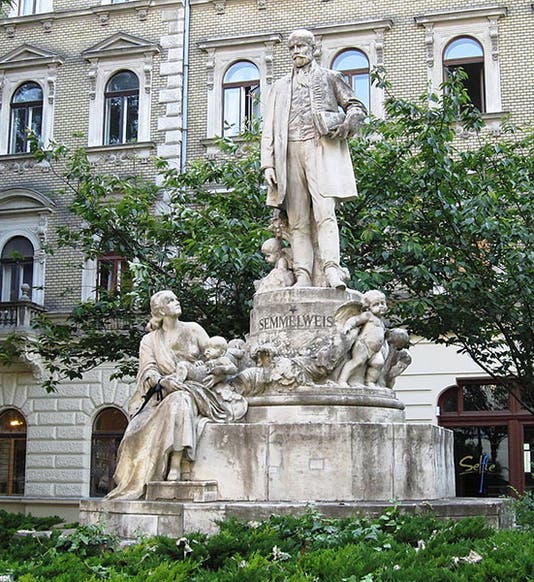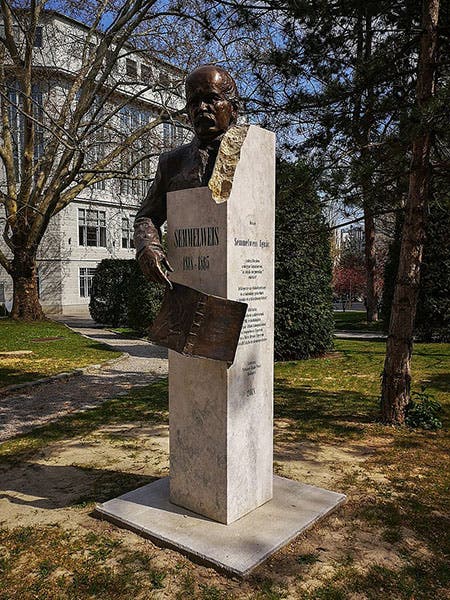Scientist of the Day - Ignaz Semmelweis
Ignaz Semmelweis, a Hungarian physician, was born July 1, 1818. In 1846, Semmelweis was placed in charge of an obstetrics clinic at Vienna General Hospital, and was trying to solve the enigma of puerperal, or childbirth, fever. Over 13% of his clinic’s maternal patients died from postnatal complications. Puzzlingly, in the other Vienna Hospital Obstetrical Clinic, set up for the teaching of midwives, the mortality rate was only 2%. Semmelweiss's clinic taught, not midwives, but medical students. He did all sorts of experiments to find the reason for the difference in mortality rate, without success.
Then in 1847, a physician colleague of Semmelweis was nicked with a scalpel while dissecting a cadaver; he rapidly developed an infection and died. Interestingly, his symptoms were similar to those of women who died of childbirth fever (which was, in fact, a horrible death). It occurred to Semmelweis that perhaps some “cadaveral material” entered the wound and caused the infection and death.
Semmelweis connected the dots. Medical students regularly dissected cadavers. And often they came directly to the obstetrics ward from the dissection room to deliver babies. They did not wash their hands because no one knew about germs in 1847, and no one understood the need for surgical hygiene. Midwives did not do dissections and so they were not bringing infectious material to their patients. Could childbed fever be prevented by removing the contaminants from the medical students’ hands?
So Semmelweis instituted a cleansing procedure, required of all students and staff at his clinic, whereby they had to wash their hands in a solution of chlorinated lime before assisting maternal patients. Within a short time, the mortality rate dropped from 13% to 2% and was now the same in both clinics.
Everyone pretty much agrees on the story thus far. What happened next is told several ways. The conventional story, as learned by most medical students, is that Semmelweis tried to convince others of the value of disinfection and the importance of hand-washing, but no one listened. Hand-washing was not generally adopted, women continued to die of childbed fever, and Semmelweis eventually went crazy. He was committed to an asylum, where he died in 1865, at age 47. Only when Louis Pasteur’s germ theory of disease, worked out between 1861 and 1864, was adopted, did physicians realize that hand-washing removes the germs that cause disease, and then Semmelweis was hailed, posthumously, as a hero.
The truth is a little more complicated. Semmelweis insisted that hand-washing would prevent childbed fever, but he refused to publish his results so others could see them (his paper did not appear until 1861). Moreover, Semmelweis insisted that cadaveral contaminants were the sole cause of childbed fever, in spite of the fact that the fever often occurred in women who could not possibly have been infected that way. He was so belligerent and inflexible that other physicians simply tuned him out. Hand-washing did become more common, especially for medical students doing dissections, but part of the reason for that was that other investigators, such as Oliver Wendell Holmes in the United States, were calling for it as good general practice. Semmelweis did become mentally deranged in 1863, and perhaps he had reason to. It must have been hard to have been ignored and shut out, when he did have the solution to preventing childbed fever, even if it was partially his own fault by being so difficult.
That said, he did discover the importance of surgical hygiene, even if he was not the only one to do so, he did advocate hand-washing, and he does deserve his status as a medical hero. One just wishes that he had also discovered that diplomacy, tact, and openness to suggestion can be just as valuable as experimental evidence in trying to effect a major change in procedure.
Last year, at the beginning of the COVID-19 epidemic, when the importance of hand-washing was suddenly in the news, NPR did a story on the father of hand-washing, Semmelweis. To set the historical record straight, they interviewed Dana Tulodziecki, a philosopher of science at Purdue, who cleared up the misconceptions surrounding Semmelweis and his achievement. Professor Tulodziecki is a former colleague of mine at UMKC and an excellent interviewee. You can listen to or read the 10-minute interview here.
Semmelweis has some good memorials scattered around the globe. We show here an older monument in Budapest (first image), and a brand-new one in Vienna (third image), as well as a postage stamp issued by Hungary in 1932 (fourth image). The view of Vienna General Hospital, the largest maternity hospital in the world at that time, is from a postcard. That was a formidable-looking institution.
Dr. William B. Ashworth, Jr., Consultant for the History of Science, Linda Hall Library and Associate Professor emeritus, Department of History, University of Missouri-Kansas City. Comments or corrections are welcome; please direct to ashworthw@umkc.edu.









